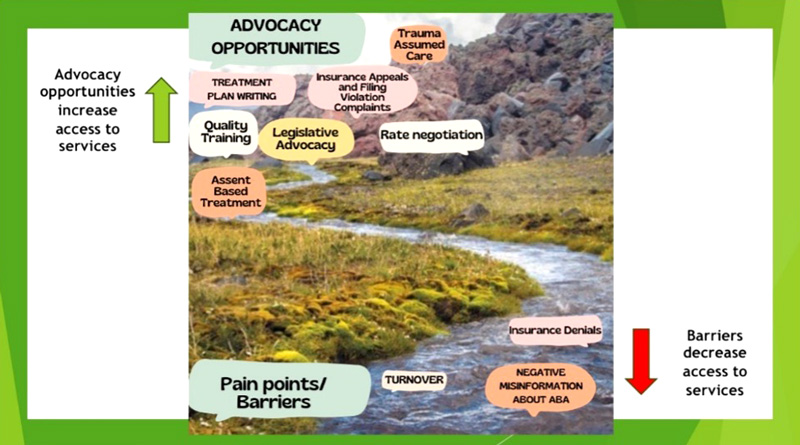When most people think of advocacy, they think of lobbying, lawsuits, or legislation. Legislative advocacy has significantly increased access to autism services over the years. However, if it isn’t something you’re already experienced with, it’s outside of your comfort zone. What you might not realize, though, is that you are likely already engaged in some form of advocacy. In autism services, advocacy takes several forms, including appealing adverse funder determinations, improving provider staff retention, increasing access to care, empowering families and individuals, fostering inclusion across settings, promoting awareness, building bridges of communication, and unifying a collective voice.

Consider this parallel adapted from a sociological discussion of illness (McKinlay, 1979): Imagine you’re standing at a river’s edge enjoying a peaceful, sunny afternoon. Suddenly, you hear a distressed commotion up the river. You look to see someone in the water, flailing as she drifts toward you. She clearly needs help. You run into the river, swim up to her, use all your strength to grab ahold of her and pull her to the riverbank. As you both begin to process what just happened, you hear more commotion from up the river. Another person is flailing and needs help. You repeat the brave and exhausting act of diving to retrieve them and bring them to safety at the river’s edge. Once again, when you’ve reached safety, you hear more commotion. You look upriver and are devastated to see several more people in distress.
At this point, you can continue to race into the river repeatedly. However, you realize this is not sustainable. Instead, you go upriver to see what is going on. WHY ARE ALL THESE PEOPLE FLAILING IN THE RIVER? You arrive at a bridge upriver and discover there is a man throwing people into the river. You approach the man and convince him to stop throwing people in the river. Boom: no more people flailing in the river. This solution made the impossible possible. But what does this have to do with ABA and advocacy?
Think of the common barriers to access to autism services. These can be barriers you face in your daily life as a caregiver, through your work as a provider in clinic, residential, home-based, or school settings, and those that you know from your families’ or clients’ experience: provider staff turnover, insurance funder denials, waitlists for services, etc. These barriers reduce access to services and are the people being thrown into the river.
Let’s examine the example of provider staff turnover. As a barrier to access to services, turnover has been thrown in and is flailing down the river. You spend all your energy on marketing, interviewing, and onboarding to get turnover out of the river, just like pulling out the people. You look upstream to realize even more turnover is flailing. Constant marketing, interviewing, and onboarding is impossible if turnover continues to be thrown in. You realize this is not sustainable, so you go upriver and determine that the thing throwing turnover into the river is a lack of quality training. So, you work with your clinical leadership to improve the quality of your training. Boom: no more turnover flailing down the river.

We’ve already considered common barriers to access to autism services. These barriers are very familiar to us because they impact the daily lives of autistic people, their families, and service providers. It is easy to identify the problems. What we may not realize or readily identify is our strengths related to these barriers. Our strengths, though, are how we stop the guy from throwing barriers into the river. Consider your strengths related to autism services. What would you feel confident training others or presenting on right now? Are you a BCBA who really connects with RBTs during training to achieve those lightbulb moments? Are you a parent who knows how to translate the ABA jargon with families new to a diagnosis? Are you an administrator who writes well and spends time putting together detailed appeal letters?
What if the strengths you identify don’t relate to the barrier being thrown into your river? Consider who else at your organization might have the strength that’s needed. Connect with your state or national resource groups, such as your local Arc, state and national trade and professional organizations, or parent-led advocacy groups. Find the folks who have the strength needed to stop your identified barrier from being thrown into the river.
Let’s return to legislative advocacy. There are some fierce trailblazers in autism services who possess strengths related to legislative advocacy and apply those strengths to legislative barriers. They push through legislation that has changed lives for the better and significantly increased access to services over decades. But it starts with imperfect blurbs written up to convey what’s needed to tackle an identified barrier by people who might feel intimidated by the legislation process (like you!). It can take years. Examples of this include:
- Meaningful Autism coverage in all 50 states took 18 years (“State Regulated Health Benefit Plans,” Autism Speaks, 2020).
- Implementation of Medicaid coverage in all 50 states occurred over the course of more than seven (7) years following a guidance notice issued by the Centers for Medicare and Medicaid (CMS) reminding state plans of their obligations under Early and Periodic Screening Diagnosis and Treatment (EPSDT). It is, therefore, a benefit only available until age 21 in most states, with advocates taking action to expand that coverage beyond 21 (“Clarification of Medicaid Coverage of Services to Children with Autism,” 2014)
We take a strengths-based approach with our children or clients every day. We should do the same with ourselves and advocate for autism services. Take your identified strengths and apply them to the barriers – stop that guy from throwing barriers into the river! Once you realize which strengths you’re already applying to advocacy, shout it from the rooftops! Boast about your new and improved quality training program and share it with your colleagues. Create a presentation of your organization-changing training process and sign up to share it at conferences or virtually with your states’ agencies and other advocacy networks. Build momentum for the advocacy you’re achieving through your strengths by showing others how they can draw from theirs to accomplish the same thing. This is advocacy. You got this!
Eileen Mendes is Vice President of Compliance and Quality at Autism Care Partners. Colleen Burnham, MBA, is Director of Operations, and Sabrina Rando, EdD, BCBA, LABA, is Executive Director at Prime Lifetime Services. For more information, email Eileen at emendes@babat.org, Colleen at CBurnham@primelifetimeservices.com, and Sabrina at SRando@primelifetimeservices.com.
References
Clarification of Medicaid Coverage of Services to Children with Autism. (2014). Department of Health and Human Services Centers for Medicaid and Medicare Services. Retrieved June 11, 2024, from www.medicaid.gov/Federal-Policy-Guidance/Downloads/CIB-07-07-14.pdf
McKinlay, J. (1979). A case for refocusing upstream: The political economy of illness. In E. G. Jaco (Ed.), Patients, physicians, and illness (3rd ed., pp. 9–25). Free Press.
State regulated health benefit plans. (2020). Autism Speaks. www.autismspeaks.org/state-regulated-health-benefit-plans





